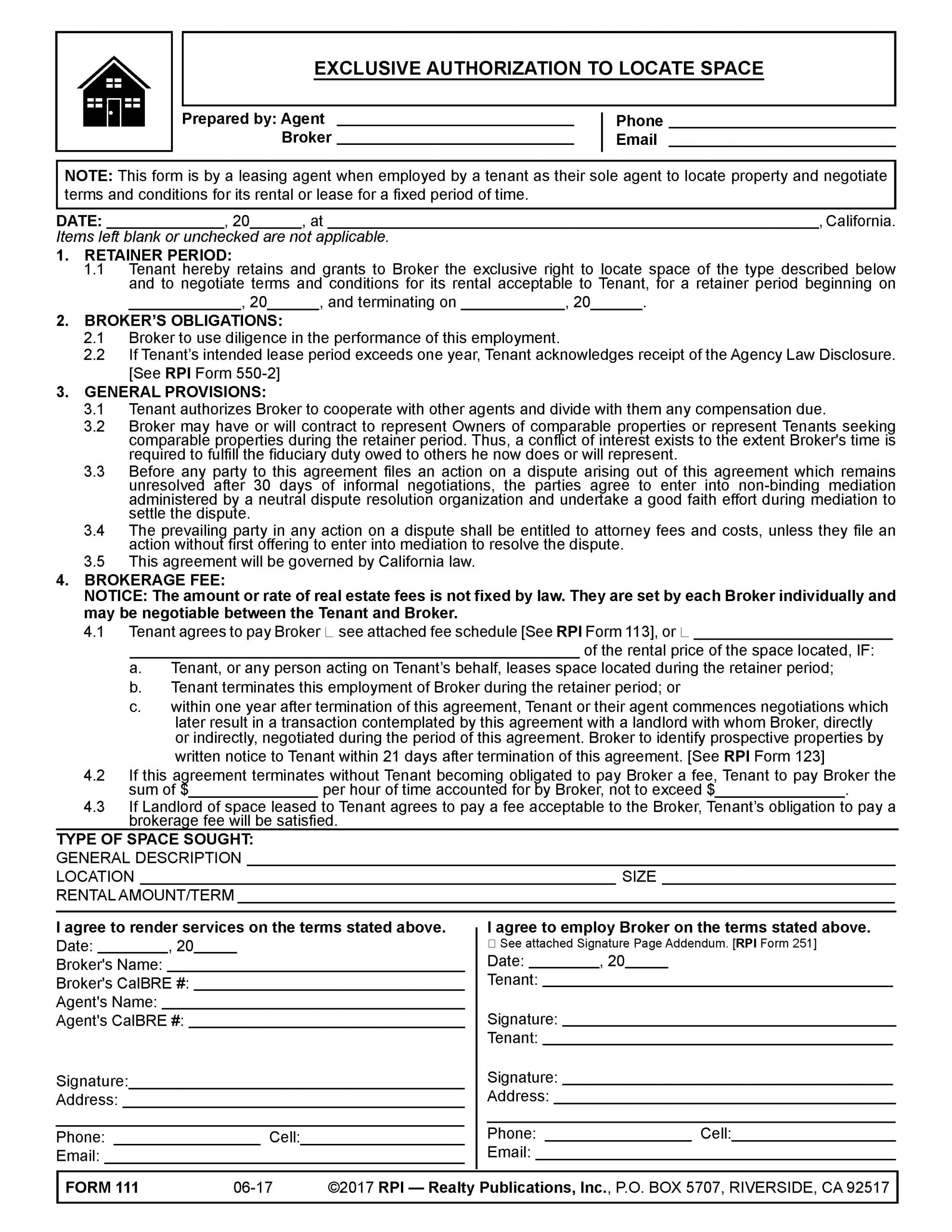Written agreements enforce collection of a fee
A broker’s assurance they will earn their fee for services rendered is required by the statute of frauds to be both:
- in writing; and
- signed by the client.
Once entered into, the written contract entitles the broker to enforce collection of the fee from the client, whether or not the broker performs as agreed.
Formal documentation of an obligation to pay a fee — a written agreement containing a fee provision and signed by the client — is the legislatively enacted and judicially mandated requisite to the right to enforce collection of a broker fee from a client who has agreed to pay it.
The written agreement contains the client’s promise to pay a fee. Critically, the client’s mere oral promise to pay a fee does not entitle the broker to enforce collection of the fee due from the client.
Thus, whenever a client employs a broker to act as their agent, the broker’s best form of fee protection is a written and signed contract — typically in the form of a listing agreement. [See RPI Form 102 and 103]
Although a seller or buyer’s exclusive listing agreement is the most frequently used contract among sellers and buyers of real estate, brokers are also frequently employed to act as leasing agents for landlords or tenants.
A leasing agent is a broker who markets the availability of space to rent and locates and negotiates the terms of a lease with suitable tenants.
Related Video: Employed to Act as an Agent
Click here for more information on written listing agreements.
Sellers and landlords, buyers and tenants
The seller’s listing agreement employs the broker as a property owner’s sole agent for a fixed period of time to list the property for sale, locate a buyer and sell the property. [See RPI Form 102]
In a similar fashion, the exclusive authorization to lease property employs the leasing agent as a landlord’s sole agent for a fixed period of time to solicit prospective tenants and negotiate a lease of a specific property. [See RPI Form 110]
Essentially, the exclusive authorization to lease property is the same side of the transactional coin as a seller’s exclusive listing agreement. The major differences are that the property is for lease, rather than for sale, and the client represented by the broker is the landlord, rather than the seller.
On the other hand, a buyer’s listing agreement employs a broker as a prospective buyer’s sole agent for a fixed period of time to prepare an offer to render services on behalf of the buyer to locate and acquire property. [See RPI Form 103]
Similarly, the exclusive authorization to locate space employs the leasing agent as a tenant’s sole agent for a fixed period of time to locate property and negotiate terms and conditions for its rental or lease. [See RPI Form 111]
The exclusive authorization to locate space is comparable to the buyer’s exclusive right-to-buy agreement, except the property sought is for rent, rather than for sale, and the client is a tenant, rather than a buyer.
Despite their differences from exclusive right-to-sell and right-to-buy listings, the exclusive authorizations to lease property and locate space are employment agreements. When they are in writing and signed by the client, the written agreements entitle the broker to receive a fee when the client’s objectives are fulfilled — in this case, the renting or lease of property.
Related Video: Types of Listing Agreements
Click here for more information on listing agreement variations.
The benefits of exclusive authorizations
Both the client and the leasing agent benefit under the exclusive authorization to lease property. Likewise, all participants benefit under the exclusive authorization to locate space.
The leasing agent benefits, since their efforts will be paid for, when:
- anyone procures a tenant for the identified space during the listing period, in the case of the exclusive authorization to lease [See RPI Form 110]; and
- the tenant enters into a lease agreement for space similar to the space sought under the exclusive authorization to locate space. [See RPI Form 111]
The client (landlord or tenant) benefit under these arrangements, since:
- the employment commits the leasing agent to fulfill the client’s objectives diligently, consistently and conscientiously; and
- the client and leasing agent work together to accomplish a single objective.
Related Video: Exclusive Listings
Click here for more information on the broker’s sole right to represent a client.
Analyzing the exclusive authorization to lease
A written agreement signed by the client is the only way a broker protects their right to compensation for services. More importantly, a written agreement memorializes the leasing agent’s obligation to work conscientiously and continuously to meet the client’s objectives, whether representing a tenant or a landlord. [See RPI e-book Real Estate Property Management, Chapter 12]
A leasing agent uses the Exclusive Authorization to Lease Property published by Realty Publications, Inc. (RPI) when employed by a landlord as their sole agent to solicit prospective tenants and negotiate a lease of a specific property for a fixed period of time. [See RPI Form 110]
The sections of the Exclusive Authorization to Lease Property include:
- Retainer period: The commencement and termination dates of the employment and a statement ensuring the broker will use diligence in the performance of the agreement. [See RPI Form 110 §1]
- Addendums: A checklist of possible addendums to attach to the agreement, including a title report or title policy, work authorization, occupant’s operating expense profile, criminal activity and security disclosure statement and lead-based paint disclosure for all one-to-four residence units constructed before 1978. [See RPI Form 110 §2]
- Brokerage fee: the broker enters the amount the client is to pay as compensation for services rendered or attaches a fee schedule. [See RPI Form 113; See RPI Form 110 §3]
- General provisions: Broker and landlord authorizations are listed and agreed to, when signed by the client. [See RPI Form 110 §4]
- Real estate: The type, address, vesting and encumbrances of record on the specific property are entered. [See RPI Form 110 §5]
- Personal property: References to any personal property included in the property for lease are entered. [See RPI Form 110 §6]
- Condition of title: The landlord’s interest in the property is to be checked (fee simple, leasehold or other). The landlord agrees there are no unsatisfied judgments or actions pending against them, no condemnation/eminent domain proceedings or other actions against the property and no unrecorded deeds or encumbrances against the property. [See RPI Form 110 §7]
- Lease terms: The broker enters the period of the lease term sought, the available date of occupancy, the initial rent amount, deposit amount, late charges and utilities, insurance payments the tenant is required to pay and the responsibilities the landlord is to maintain. A blank space is also included for the broker to enter any other lease terms that may apply. [See RPI Form 110 §8]
- Signatures and identification of the parties: The parties enter their information and sign to agree to the employment on the terms stated in the form. [See RPI Form 110]
Related article:
Form of the week: Exclusive Authorization to Lease Property and Schedule of Fees — Forms 110 and 113
Analyzing the exclusive authorization to locate space
A broker needs to enter into an employment agreement with a tenant before extensively analyzing the tenant’s needs for space the broker intends to locate. As a matter of best practices, the employment agreement is entered into and signed prior to locating space or exposing the tenant to available space not listed with the broker. [See RPI e-book Real Estate Property Management, Chapter 13]
A leasing agent uses the Exclusive Authorization to Locate Space published by RPI when employed by a tenant as their sole agent to locate property and negotiate terms and conditions for its rental or lease for a fixed period of time. [See RPI Form 111]
The sections of the Exclusive Authorization to Locate Space include:
- Retainer period: The commencement and termination dates of the employment is entered. [See RPI Form 111 §1]
- Broker’s obligations: The broker agrees to use diligence in the performance of the agreement and when the tenant’s intended lease period exceeds one year, the tenant acknowledges their receipt of the Agency Law Disclosure. [See RPI Form 550-2; See RPI Form 111 §2]
- General provisions: General information for the tenant is listed. [See RPI Form 111 §3]
- Brokerage fee: The broker enters or attaches a fee schedule to set the amount the broker will receive from the tenant for services rendered. [See RPI Form 111 §4]
- Type of space sought: The broker enters the general description, location, size, rental amount and rental term of the tenant’s desired property. [See RPI Form 111]
- Signatures and identification of the parties: The parties enter their information and sign to agree to the employment on the terms stated in the form. [See RPI Form 111]
Related article:
Want to learn more about assisting landlords and tenants? Click the image below to download the RPI book cited in this article.



















